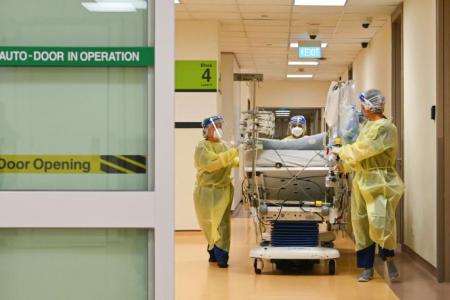Ong Ye Kung: Covid-19 restrictions can be eased once Omicron wave has peaked and starts to subside
The timeline to ease current Covid-19 restrictions depends on the epidemic situation, and the number of deaths is one of the key indicators to tell if Singapore's healthcare system is able to cope with the Omicron wave, said Health Minister Ong Ye Kung in a written parliamentary reply on Monday (Feb 14).
Mr Ong was responding to Mr Lim Biow Chuan (Mountbatten SMC), Mr Christopher de Souza (Holland-Bukit Timah GRC) and Mr Gerald Giam (Aljunied GRC), who asked about the target criteria to ease up on current Covid-19 restrictions and to allow social gatherings of more than five.
"We will continue to monitor the key indicators closely to make sure our healthcare system can cope as we ride through the Omicron transmission wave. Once it has peaked and starts to subside, we can look forward to easing our safe management measures," said Mr Ong.
During the peak of the Delta wave from late October to early November, there were about 13 deaths a day, he said.
In the past two weeks, despite cases being three times more than during the Delta wave as the Omicron variant is more infectious, there have been an average of two to three deaths a day.
"But there had been days when deaths were also more than five. We have to watch the trend very closely, but for now, the case mortality due to the Omicron variant is not very different from the number of deaths related to various viral infections pre-Covid-19," said Mr Ong.
"The number of cases in intensive care units (ICUs) is another key indicator, and current figures show that the intensive care wards are not "coming under pressure and are in good shape", he said.
There are around 30 patients in ICUs across hospitals, compared with 170 patients at the peak of the Delta wave, said Mr Ong, noting that around 0.05 per cent - or five in 10,000 - of Covid-19 cases require intensive care currently.
The duration of stay in ICU is also shorter, typically three to five days, compared with the average 11 days' stay by Delta patients.
There are 113 ICU beds now, which can be ramped up to 350 at short notice and to 500 beds should the need arise, Mr Ong said.
Currently, around 130 patients require oxygen supplementation, which is around 40 per cent of the peak of the Delta wave, he added.
The biggest constraint is the number of hospital beds, as there are around 1,200 Covid-19 patients currently hospitalised, said Mr Ong.
Of these, around 30 per cent are "incidental cases", meaning they were admitted for non-Covid-19 conditions and subsequently found to be infected as patients are tested during their stay.
"In other words, they do not take up extra beds due to their infection. So the extra workload on our hospitals is two-thirds of the 1,200 hospitalised cases," said Mr Ong.
Patients infected with the Omicron variant also have a shorter hospital stay of about three to four days, compared with five to eight days for those infected with the Delta variant, so beds are freed up faster, he added.
Additionally, there are about 3,800 beds in Covid-19 treatment facilities, which will be ramped up to 4,600 by the end of this month.
On top of these key indicators, it is also important to monitor the state of healthcare manpower, noted Mr Ong.
The attrition rate of doctors from public acute hospitals has remained comparable with the rate in 2019, at around 3 per cent to 5 per cent, while nurses' attrition rate was about 8 per cent in 2020 and 2021, comparable with that in 2019. The absenteeism rate due to Covid-19 is around 2 per cent, he added.
"We do not take this for granted and will continue to support our healthcare professionals. We are also working closely with clusters to help them recruit new healthcare workers," said Mr Ong.
In a separate written reply to Mr Louis Chua (Sengkang GRC), Mr Ong noted that about 887,000 health risk warnings (HRWs) were issued between Oct 11 last year and Jan 31 this year.
Close to 60 per cent were household contacts of Covid-19 cases, while the remainder were identified by TraceTogether, SafeEntry and other forms of contact tracing, he said.
Around 10 per cent of those who received HRWs eventually tested positive, with household contacts more likely to be infected than workplace or social contacts picked up by contract tracing, added Mr Ong.
Get The New Paper on your phone with the free TNP app. Download from the Apple App Store or Google Play Store now


